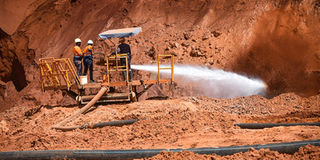Boost mineral exploration in coast counties to spur growth

A mining site at Kenya's coast.
Minerals are a principal source of income for many developing countries. But Kenya has stagnated in its mineral exploration plan, even after the advent of devolution. The country has a huge potential in mineral exploration,a good example being Kilifi County.
Just as its neighbour, Kilifi has vast mineral deposits whose exploitation could boost the region’s economy. In 2013, estimates from mining firm Base Titanium showed the county had 10 times more titanium than Kwale. Rare earth and niobium minerals worth Sh5 trillion were discovered at Mrima hills.
Kilifi has approximately 1.4 billion tonnes of titanium with Vipingo, Mambrui and Sokoke areas, which carry the biggest deposits, covering 450.7 kilometres. The titanium mines in Kwale are expected to last 10 years and the company is eyeing 1.4 million tonnes with the first export next January.
By then, the firm reported that it had planned to make mineral exports worth $60 million (Sh5 billion) every year, most of which was to be injected directly into the economy. It has further invested at least $9 million in schools, a healthcare centre, a public hall and boreholes in Kwale. The focus was to shift to Kilifi, whose mineral wealth is untapped.
In 2015, the county was in talks with investors to build a port and also prospect for petroleum and natural gas at Ngombeni. The government released Sh1.5 billion in mineral royalties that is lying in the National Treasury.
The Mining ministry promised to open a County Mineral Royalties Account, into which 30 per cent of the collections would be deposited. The Mining Act, 2016 stipulates that royalties be shared between the national and county governments and communities at the ratio of 70:20:10.
Enabling regulatory and institutional frameworks and policies, as well as efficient extension services, can help to support the livelihoods of small-scale miners. World over, work in small-scale mines tends to be low-paid, seasonal and highly precarious. But it provides direct employment, though often at a subsistence level, for up to 13 million workers who generate 15-20 per cent of the world’s production of precious metals, gems, building materials and (mostly) non-fuel minerals, an ILO survey shows.
As many as 80-100 million people depend for their livelihoods on the often scant proceeds of small-scale mining, roughly the same amount as for the more visible, large-scale mining sector, but most of the former gain a very meager living.
Kilifi should collaborate with the national government to tap more into the mining sector. The many benefits of mining include reducing rural-urban migration, maintaining the link between people and the land; making a major contribution to foreign exchange earnings; enabling the exploitation of what would otherwise be uneconomical resources; and being a precursor to large-scale mining.
Lastly, the government must ensure that title and property rights over minerals are straightforward to acquire and transfer; access to finance for small-scale mining is on equal terms with other sectors where the labour and social issues are addressed; and the working and living conditions of small-scale miners and their communities are improved.
Mr Kithi is an advocate of the High Court of Kenya. [email protected].





